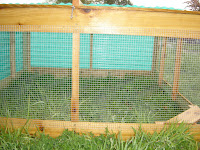A new build to allow us to handle more birds at once while raising the Cornish X. With the new federal regulations for raising Cornish Cross (Meat Chickens) expanding from 1.3 square feet to 1.5 square feet and the recommendation being 2 square feet per bird, we have upgraded our pen situation while making it easier to move. The pen is 36 square feet of outdoor space (enough for 25 meat birds at 1.5 sq.ft.), and depending on the size of a portable coop for cooler weather situations, can easily bump this up to 50 sq.ft. with a 4x4 basic outbuilding on skids. The reason the space can be this minimal is that the birds are to be moved to fresh pasture daily until they are processed. This would never be enough outdoor space for 25 layers even if you moved them every day! While we had a 4x4 build for our turkeys, that only lasted a few years and we will need to build a better outbuilding. The last one was on the cheap and the siding/flooring started to get mold and rotting so the point it was no longer safe to use. We will, most likely, build it more like a "dog house" next time since we don't need the height for the meat chickens that we needed for the turkeys.
The pen is built with cedar fencing 6', and 2"x2" pine support pieces. We plan to paint the wood to help it last longer. The roof can be flipped up or removed. The wired front lid can be unlatched for sliding/moving (these latches are locking hooks and screw-eyes). For now, the pen build.
This is a rendition of Lumnah Acres $30 Coop, which was built in 2017, and even then, those prices were lower than here in the PacNW. In this build, the wood was $70, the 25' roll of hardware cloth was $30, and the corrugated plastic roof panels were $38. Plus the hardware/fasteners about $10ish. We always use hardware cloth. We have coyotes that sit in our field and watch the chickens, hoping to figure out how to get at them. Plus there are frequent spotting reports of cougars in our area. Chicken Wire is No Match to these Hunters. For now, while we don't have a coop to use for the birds this spring, we will slide a pallet inside the pen at night so they can get up off the wet ground at the same time we are removing their feeder for the night.
The Production Blue Roos and Pullets that we had hoped to have picked up this weekend are NOT ready for living outdoor in a coop. One of the Roos has been slower to develop. While he finally caught up by size, he has yet to fully feather. They are very pretty birds. The feathers on the front of their necks/chest have developed some hint of their Rhode Island x-breeding, while the rest of them look a bit more of the Blue Andalusian. The Pullets have a hint of black on their tiny combs (which will develop more later when they are ready to start laying eggs) while the Roos combs and waddles are a bit more developed, and pink/reddish. Their eye coloring is very pretty. I needed to pull them out of the brooder because I needed that space for the meat chicks at this point. So the Production Blues are in the large rabbit pen for now, while the brooder is dedicated now for the Cornish X Fluffballs. PS, I don't use heat lamps for fluffballs. I use the warming plates inside the brooder and a space heater close but outside the brooder to keep the area temp from dropping below 60F. The chicks will move back under or lay on top of the warming plates as needed without impacting their health or growth rate, similar to if they were being raised by a hen. So much easier than dealing with heat lamps.
In the photos below, the meat chicks have two feeders at this point along with a one gallon water dispenser. The small green feeder is what they started with. During the first week, we grind up their start (feed) crumbles to make it a bit easier for them to eat in the smaller green feeder. That green feeder is there as an "assurance" to them now, even though it does not have much food in it. They will all gradually move onto the larger red feeder. But if we take the green one out too soon, they will panic and get stressed out. We do the same transition thing with the water dispenser. Silly Chicks!












